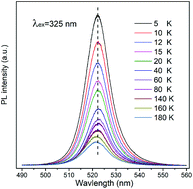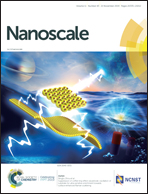Anomalous variable-temperature photoluminescence of CsPbBr3 perovskite quantum dots embedded into an organic solid
Abstract
All-inorganic lead halide perovskite quantum dots (PQDs) of CsPbBr3 were synthesized at room temperature via a facile solution-based procedure. The cubic phase structure of the synthesized PQDs was judiciously identified through examining high-resolution transmission electron microscopy (TEM) images, selected area electronic diffraction (SAED) patterns and scanning TEM images of the PQDs. Variable-temperature photoluminescence (PL) spectra of the CsPbBr3 PQDs randomly embedded into a frozen solid of methylbenzene were measured in the temperature range of 5–180 K. It is found that both the linewidth and peak position of the measured PL spectra are abnormally almost temperature independent in the temperature range of interest. Some competing mechanisms, such as a competition between the bandgap blue shift induced by thermal lattice expansion and red shift induced by thermal escaping of localized excitons, and a competition between lineshape broadening by phonon scattering and narrowing by thermal escaping of localized excitons, are proposed to interpret the phenomena. Good agreement between the theoretical fitting and the experimental data leads to a state-of-the-art understanding of the temperature-dependent luminescence of the CsPbBr3 PQDs in a solid matrix.



 Please wait while we load your content...
Please wait while we load your content...